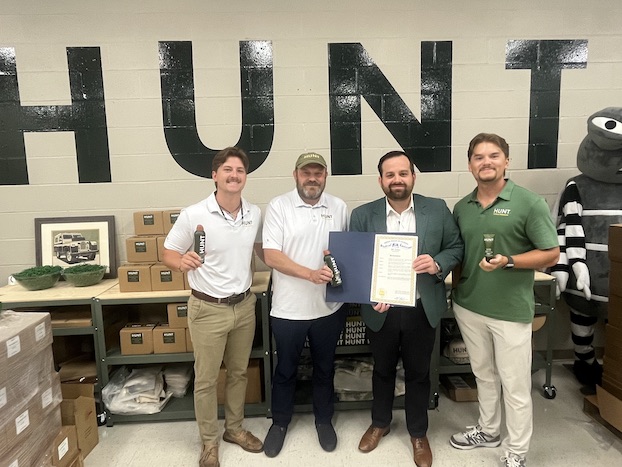Plantation House becomes home
Published 3:35 pm Monday, December 1, 2014
Samantha and Randy LeJeune know old houses inside and out
Samantha Lejeune remembers when her parents, Reuben and Ethel Broussard, took her on a Louisiana plantation tour. Afterward, her thoughts were filled with images of living in a grand old home dressed in a big hoop skirt. “I was seven years old and obsessed with the idea for a while,” she said, smiling.
When she finally moved into a charming home on Division Street in the Lake Charles Charpentier District, she met someone with the same passion for historical homes. Randy Lejeune valued the city’s surviving architecture and potential for revitalization as much as Samantha did.
Trending
Together they decided to tackle the home they’re in now. Samantha finally got her very own plantation house, hoop skirt not included.
The grand three-story Lejeune property on the corner of Broad and Reid Streets not only looks like a plantation with its double galley with porch ceiling of blue to discourage dirt daubers. It was also, at one time, The Plantation House, a popular seafood restaurant. The house is elegantly decorated. But one of the fun and most fitting displays includes the framed menu from the Plantation House. Crawfish Imperial was $3.15.
“This house was built by Chester Brown, a Michigan Man in 1904,” Samantha said.
In an American Press Home and Real Estate article, Adley Cormier wrote about these men and their lasting impact on the city’s architecture. “ Broad Street was once the principal east-west thoroughfare in the city and was once part of “Old Spanish Trail,” a transcontinental road in the 1920’s that connected San Diego, Ca. to San Augustine, Fl. On its eastern residential end from Hodges Street to Enterprise Boulevard, it served as a showcase for grand, palatial mansions generally called ‘Michigan Man houses’.”
These early settlers were entrepreneurs from the North (who might have been called “carpetbaggers” in other parts of the South). Here they were called “Michigan Men” after the state that many of them called home.” Many owned or operated lumber mills. The houses they built reflect a wide range of styling influences and serve as silent testament to the vibrant era of growth and development when lumber was king in Southwest Louisiana, according to Cormier.
Since the house was built before the great fire, research about past owners was a challenge. Samantha did discover that Chester Brown was the treasurer for the Ramsey Lumber Company, but was not able to determine why he remained in the house for only two years. George Locke purchased the property in 1912. The Seiss family owned the house for over 20 years, through the 1950s. In the late 60s, the house became The Plantation House owned by the Guidry family. After the Guidrys closed The Plantation House, the imposing Broad Street structure became the Hunan Inn until right after Hurricane Rita, according to Samantha.
Trending
“When we looked at the house, everything was still in here, the tables, the dishes, the glasses, the silverware, everything,” Samantha said. But she saw the house as it could be and work commenced on restoring it. The first order of business was a sale to empty the rooms of the restaurant items. Carpet covered the wood floors. The wood paneling and flight of stairs had been walled up and cordoned off. Samantha names the wood paneling along the stair way as the biggest pleasant surprise discovered after Randy and his Rhino Renovators crew got busy working. Since Randy and Samantha are seasoned house fixer uppers with real estate savvy – she’s a broker for Rhino Real Estate – they knew what they were up against when they purchased the home. There was termite damage. Work that wasn’t original to the house was identified and torn out, including a bar and the tinted glass added to the porch to make the area were restaurant patrons waited before being seated.
Some of the very first and finest electrical chandeliers remain in the home, a beautiful reminder of days gone by as well as two great stories that Samantha related. When a person who was familiar with the house when it was a restaurant saw the house after the renovation, she remarked at the beautiful new fixture in the main parlor. But it wasn’t new; the grime had been washed away revealing the detail and quality of the chandelier.
The other is the story of when the Guidrys expected Liberace to grace their restaurant. To prepare for the event, they removed a flashy chandelier and installed something more modest in preparation for the visit, as a way to ensure that Liberace, and his signature way of dressing, would be brightest shining object in the room. After they did all that, Liberace didn’t show up Samantha was told.
For two years Samantha and Randy worked on scraping away the restaurant leftovers to find the house built over 100 years ago. The couple exchanged wedding vows there in July of 2007. “I came down the staircase. We weren’t finished with the house, but we did have a single coat of paint on the walls and a coat of polyurethane on the floor.” Samantha recalled. The reception was in a room that had been added onto the original structure. “We stapled fabric to the walls to cover the plywood.” The plywood floor of that area is now covered with pavers that have been sealed to a shine, giving the area a warm, old world feel. Samantha said that this method is comparable to the price of tile.
The LeJeunes lived downstairs while the upper floors where being renovated and moved upstairs as the lower level was completed.
Samantha did the decorating, including making the curtains for the house. The beautifully refinished floors now hold antique wool rugs and period furnishings and décor like the 1800s Plantation Grand piano and a “Gone with the Wind” lamp from the Joe Cash house. Many of the lighting fixtures are antique. One of these include one of the lights that hung over a teller as she worked at the old Calcasieu Marine bank building.
A bevvy of 19th century well-dressed women stare silently from the walls surrounded by gilded frames. These fine art paintings of all sizes are found throughout the home. Small pine coiled lidded baskets made by the Coushatta Indians grace a shelf in the breakfast room. Also of interest: an extensive collection of Bosson heads and a floor to ceiling free standing mirror that “came with the house,” according to Samantha. A painting by local artist Lisa Reinauer of her mother hangs on a second story wall. It’s painted on roofing paper. Paintings by James Hunter, the grandson of Clementine are featured and a very striking paining that was featured at one time in Art Magazine that depicts Abraham and Issac in modern dress hangs in the home’s second story landing. Vintage signs and Mardi Gras parade float pieces help round out this eclectic art collection.
Personal mementos are also on display in the home. Though there are no Gone with the Wind hoopskirts to be found in the old Plantation House, except in some of the paintings, there is a vintage style dress on display in one of the upstairs rooms. It is the dress that Samantha wore for the talent (WHAT) Miss McNeese (YEAR).
An idea that others can use in their homes, plantation or not, is the way that Samantha displays her crowns from past competitions and Randy’s medals from his days as a professional bicycle racer. Rhino was the name of his Arizona team. The bling of the medals and crowns rest in and spill from rustic old soda bottle crates, displayed with antique duck decoys.
Samantha and Randy make a formidable team. She lists the homes through Rhino Real Estate that he renovates through Rhino Developers. Off the top of her head, she counted at least 20 in the neighborhood that they’ve had a hand in restoring. Rhino Property Development Company, a third LeJeune company, established the Old Tremé Properties on the corner of Common and Clarence. These houses were modeled on home from the oldest black neighborhood in America, a place that helped shape American culture. There’s one original building in the development that has been restored. Two are new homes (that look old) and a third is under construction and will be on the market soon.
The Shadows at Bayou Oaks is a second development that’s east of the Choupique Bayou in Carlyss. These homes will be built in the style of a creole cottage. “The engineer is doing the final work and hopefully we will be ready to start roads in the first quarter of 2015,” Samantha said.
In 2011 the couple won the CALCA commendation award from the Calcasieu Historical Preservation Society for their work in relocating, renovating and building appropriate residential infill.
In response to the question, what makes a house a home, Samantha wrote the following: “I think love and happiness that comes from within create the atmosphere of a home. Without it, it’s a cold hostile building.





